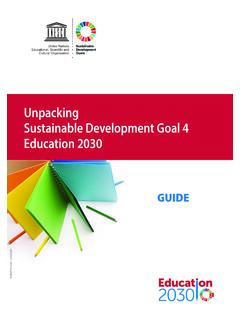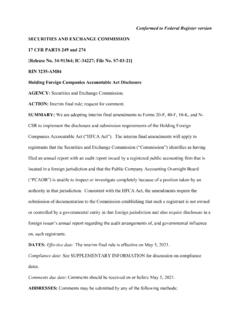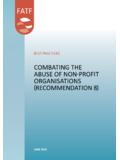Transcription of Gender Discrimination in Education: The violation of ...
1 Gender Discrimination in Education: The violation of rights of women and girlsGlobal Campaign for EducationFebruary 2012A report submitted to the Committee on the Elimination of Discrimination against Women (CEDAW) TABLE OF CONTENTSG lobal Campaign for EducationPART I: Introduction ..3 CASE STUDY 1: Bolivia ..5 PART II: The nature of Gender Discrimination in education ..6 PART III: Necessary state action ..9 PART IV: Initial survey results ..10 CASE STUDY 2: Armenia ..12 PART V: Conclusions and recommendations ..14 REFERENCES ..15 CASE STUDY 3: Pakistan ..16 CASE STUDY 4: Tanzania ..17 ANNEX 1: Availability Table ..18 LIST OF FIGURESF igure 1: Percentage of respondents unhappy being a girl or a boy ..10 Figure 2: Gender stereotyping of subject aptitude ..11 Figure 3: Teachers experience of Gender Discrimination ..11 This report is independently published by the Global Campaign for Education (GCE). GCE is a civil society coalition which calls on governments to deliver the right of everyone to a free, quality, public education.
2 Global Campaign for Education 2012 All rights reserved25 Sturdee AvenueRosebank, Johannesburg 2132 South image: GCE Mozambique (Movimiento de Educa o para Todos)Pages 8-9 image VSO RwandaPage 13 Agencia Brasil/Marcello Casal JrAll other images Global Campaign for Education PART 1: Introduction1. There are multiple and diverse links between Gender equality and the fulfillment of the human right to education. The pervasive denial of the human right to education experienced by women and girls across the globe as shown, for example, by the fact that two thirds of the world s non-literate adults are women is a striking example of Gender Discrimination . Education is an enabling and transformative right. As pointed out by the Committee on Economic, Social and Cultural Rights (CESCR), the right to education has been variously classified as an economic right, a social right and a cultural right. It is also a civil right and a political right, since it is central to the full and effective realization of those rights as well.
3 In this respect, the right to education epitomizes the indivisibility and interdependence of all human rights i. A strong education system, in line with the principle of non- Discrimination , is key for redressing Gender injustice in wider society, and for overcoming social and cultural norms that discriminate against girls and women. CESCR has also clearly stated that the prohibition against Discrimination enshrined in article 2 of the Covenant [of Economic, Social and Cultural Rights] is subject to neither progressive realization nor the availability of resources; it applies fully and immediately to all aspects of education and encompasses all internationally prohibited grounds of Discrimination . The Global Campaign for Education (GCE) therefore sees the challenge posed by Gender Discrimination in education as multiple: policy and practice in education needs to be re-oriented to ensure the deconstruction of Gender stereotypes as well as the promotion of equality of experience and relations for both sexes in education, thus addressing power imbalances that perpetuate Gender inequality and leveraging access to all rights by woman and girls.
4 2. Education is strongly embedded in CEDAW, in ways that reflect this rich relationship between Gender equality and the right to education. CEDAW article 10 explicitly enshrines the right to equality in education, while many other articles notably 5 (on social and cultural norms), 7 (on civil and political participation), 8 (on international representation), 11 (on employment), 14 (on the social, economic and cultural rights of rural women) and 16 (on rights to and within marriage, and women s reproductive rights) express rights of which the full realization is very strongly dependent on addressing Gender Discrimination in education. Moreover, CEDAW s General Recommendation 3, as well as article 10 of the main convention, expresses clearly the role of education in addressing wider Gender Discrimination based on stereotyping and biased cultural The human right to education and non- Discrimination is further affirmed by a number of other international treaties. Along with the clear expression of a universal right to education in Article 26 of the Universal Declaration of Human Rights, and the provisions on Gender -equitable education in CEDAW, the most significant expressions of these rights are found in the Convention on the Rights of the Child (CRC, 1989), the International Covenant on Economic, Social and Cultural Rights (ICESCR, 1966) and the 1960 UNESCO Convention against Discrimination in Education.
5 Governments further committed themselves to ensuring Gender equality in education in the Dakar Framework for Action (2000), the Millennium Development Goals (2000), the Beijing Declaration and Platform for Action (1995) and the World Declaration on Education For All (1990), which stated that the most urgent priority is to ensure access to, and improve the quality of, education for girls and women, and to remove every obstacle that hampers their active participation. Yet despite these numerous treaties, States and the international community still largely treat education as a development goal and not as a right. GCE believes that a clear rights-based understanding of education is crucial to overcoming Gender Discrimination and to re-orienting education towards the promotion of greater Gender equality in society as a There has been undeniable progress made in improving Gender parity in education in the three decades since the entry into force of CEDAW. Parity in enrolment has accelerated over the 22 years since the first agreement of the Education For All framework in Jomtien, and since agreement of the Millennium Development Goals in 2000.
6 The number of girls out of school fell by more than 40% from 1999 to 2008ii, and girls now constitute 53% of those children out of school, as opposed to 60% at the start of the millennium. The MDGs called for Gender parity at primary and secondary education by 2005, a target that was clearly missed; nevertheless, it is encouraging that at an aggregate level, the world is now closer to achieving Gender parity, at least so in primary education. 5. Progress on enrolment, however, should not mask the fact that girls and women continue to be denied their rights throughout the education cycle, and still face huge Discrimination and disadvantage in terms of access, progress, learning and their experience in schools. The target of achieving Gender parity in school enrolments gained significant traction in the international community not least because of its inclusion in the Millennium Development Goals (MDGs). But the consequent progress has led to a dangerous complacency about the reduction of Gender inequality in education.
7 Girls are still far more likely to drop out before completing primary education, have markedly worse experience in school, often characterized by violence, abuse and exploitation, and have scant chance of progressing to secondary school and tertiary education. The preliminary findings of GCE s global survey of Gender in schools show that more than one fifth of girls in secondary schools are unhappy Gender Discrimination in Education: The violation of rights of women and girls3with their Gender , and nearly two fifths have been made fun of at school for being a girl. In sub-Saharan Africa, there is a 10 percentage point gap between girls and boys primary school completion rates, and in only seven of the 54 countries in sub-Saharan Africa do girls have a greater than 50% chance of going to secondary school. GCE s survey shows that Gender stereotypes still prevail in schools, particularly around male and female aptitudes, as do unequal power relations, as shown in, for instance, the fact that girls are far more likely to perform classroom chores.
8 This perpetuates Gender inequalities within the education system and society as a whole. It is hardly surprising, then, that nearly two-thirds of the world s illiterate people are women. True Gender equality in education and beyond remains far from being The Global Campaign for Education (GCE) is a civil society coalition which calls on governments to act immediately to deliver the right of every girl, boy, woman and man to a free quality public education. Since our formation in 1999, millions of people and thousands of organizations including civil society organizations, trade unions, child rights campaigners, teachers, parents and students have united to demand Education for All. We believe that quality public education for all is achievable, and we therefore demand that governments north and south take their responsibility to implement the Education for All goals and strategies agreed by 180 world governments at Dakar, in April 2000, and since agreed time and again.
9 7. GCE s Global Action Week in 2011 focused on Gender equality in education. GCE mobilized members and schools in over 100 countries to discuss Gender Discrimination in education, and to call for politicians to Make it Right for Gender equality in education. We presented parliamentarians, ministers and heads of state with demands in the form of manifestos and petitions. Our coalitions joined forces with national women s groups 4 Global Campaign for Educationand enlisted the support of high-profile women to amplify our demands. The GCE coalition continues to campaign and lobby on the global, regional and national stage to ensure Gender justice prevails within and beyond With this report, GCE seeks to present the CEDAW committee with information that indicates the current state of Gender equality in education globally. In order to do so, we draw on GCE s own report jointly produced with RESULTS from 2011, Make It Right: ending the crisis in girls education, which included an analysis of girls education in 80 developing countries; on information supplied by GCE member coalitions before and during 2011 Global Action Week on Gender and education and on the preliminary results of ongoing participatory research on Gender Discrimination in schools, which GCE and its membership is conducting with students, teachers and the community.
10 Part II of this report sets out the rights-based framework through which we will analyze Gender equality in education, and presents an overview of progress and key areas of concern, while Part III indicates the kinds of State actions needed to address these issues. In Part IV, we present the preliminary results of the participatory research (due to be concluded in mid-2012 and the conclusions from which shall be formally presented to CEDAW). We finish with conclusions and recommendations in Part V, with our predominant focus on national-level action that can and should be taken by CEDAW s State signatories, in terms of the legal, political and financial frameworks that will support Gender equality in education. The report also includes brief national case studies, from different regions, which present examples of some of the different forms of Gender Discrimination in education. The premise of this report is that human rights law should be more explicitly recognized as the primary foundation for efforts to achieve Education For All, and more specifically Gender equality in education, and that this recognition will entail an appropriate focus on State responsibility and capacity.





